Abstract
Athletic trainers have a variety of therapeutic agents at their disposal to treat musculoskeletal pain, but little objective evidence exists of the efficacy of the modalities they use. In this study, delayed onset muscle soreness (DOMS) served as a model for musculoskeletal injury in order to: (1) compare the changes in perceived pain, elbow extension range of motion, and strength loss in subjects experiencing DOMS in the elbow flexor muscle group following a single treatment with either transcutaneous electrical nerve stimulation (TENS), cold, a combination of TENS and cold, sham TENS, or 20 minutes of rest; (2) compare the effects of combining static stretching with these treatments; and (3) determine if decreased pain is accompanied by a restoration of strength. DOMS was induced in the non-dominant elbow flexor muscle group in 40 females (age = 22.0 ± 4.3 yr) with repeated eccentric contractions. Forty-eight hours following exercise, all subjects presented with pain, decreased elbow extension range of motion, and decreased strength consistent with DOMS. Subjects were randomly assigned to 20-minute treatments followed by static stretching. Cold, TENS, and the combined treatment resulted in significant decreases in perceived pain. Treatments with cold resulted in a significant increase in elbow extension range of motion. Static stretching also significantly reduced perceived pain. Only small, nonsignificant changes in muscle strength were observed following treatment or stretching, regardless of the treatment group. These results suggest that the muscle weakness associated with DOMS is not the result of inhibition caused by pain. The results suggest that these modalities are effective in treating the pain and muscle spasm associated with DOMS, and that decreased pain may not be an accurate indicator of the recovery of muscle strength.
Full text
PDF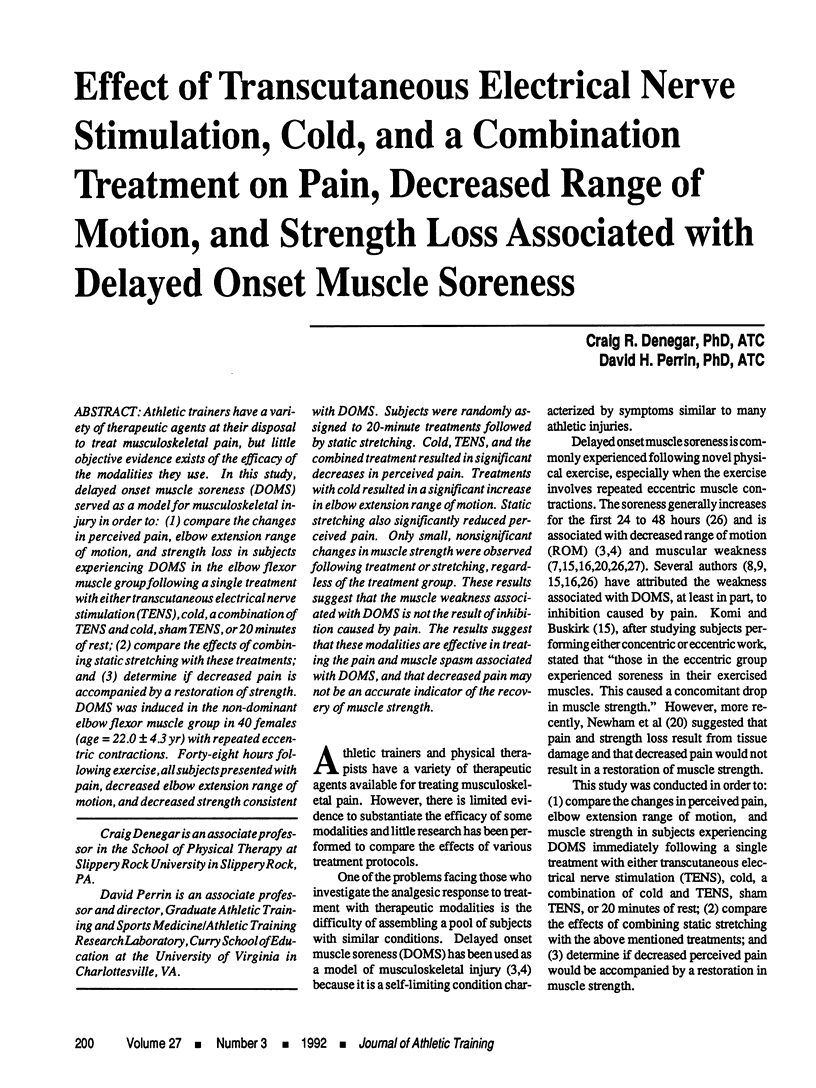
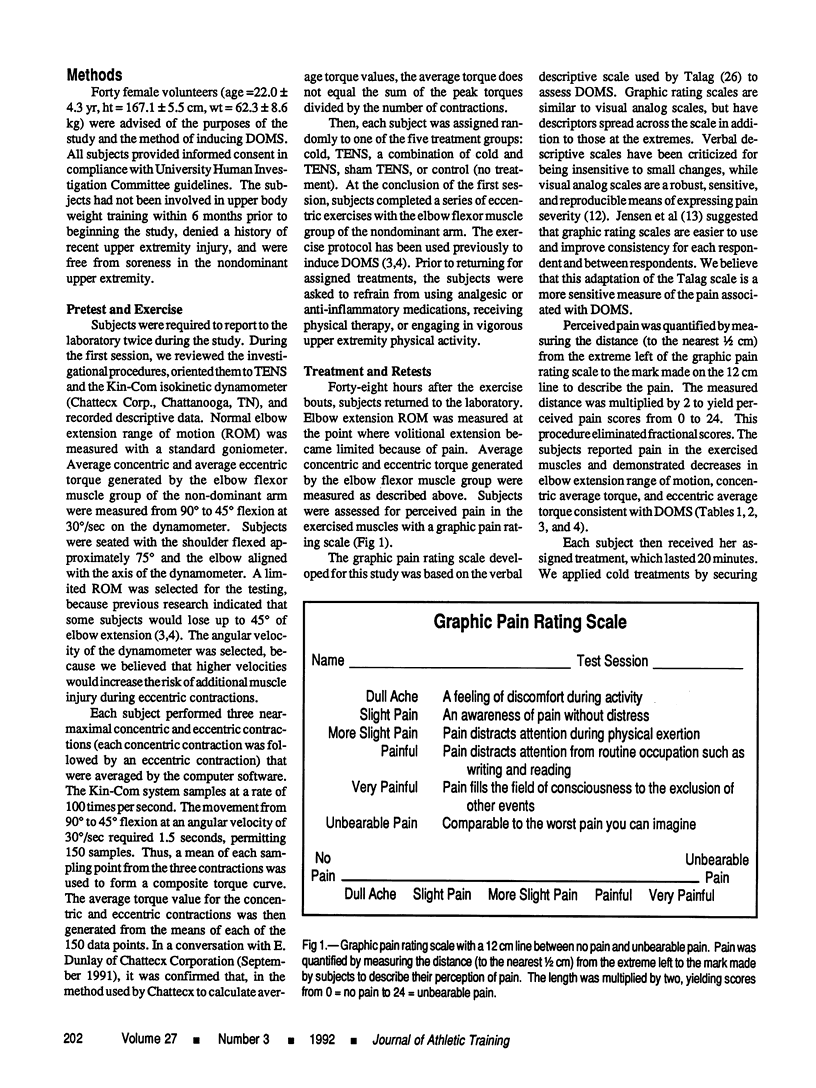
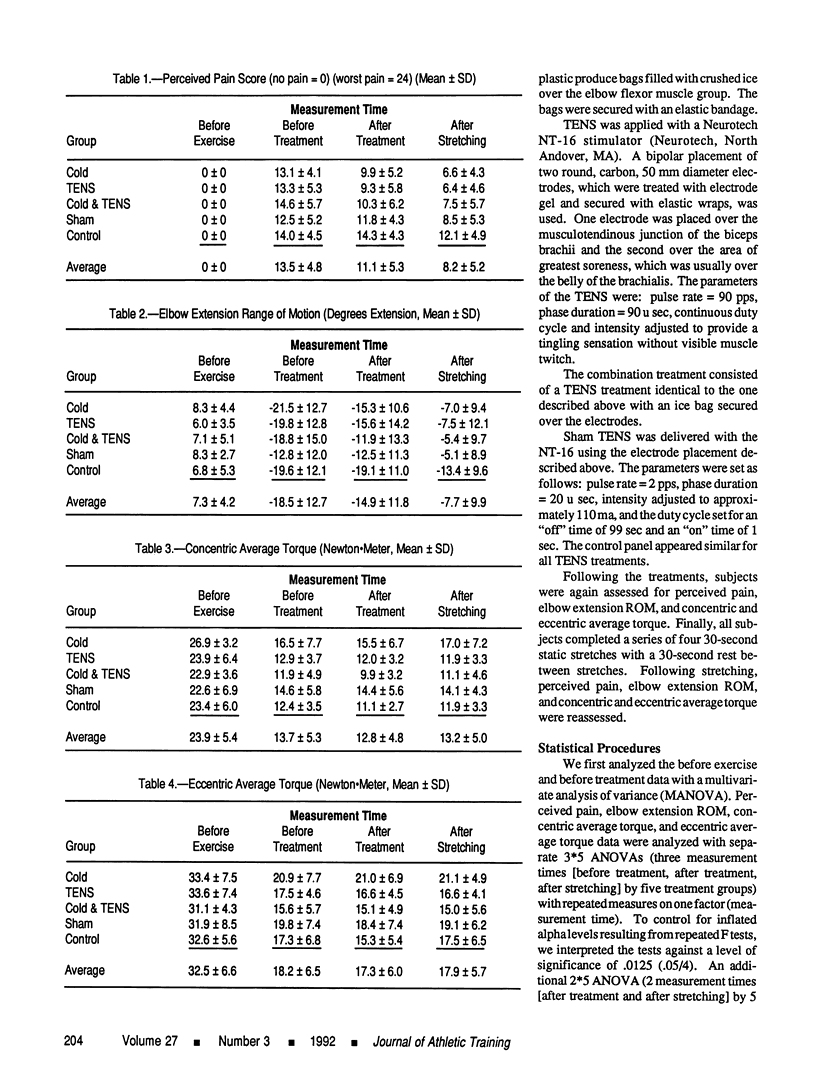
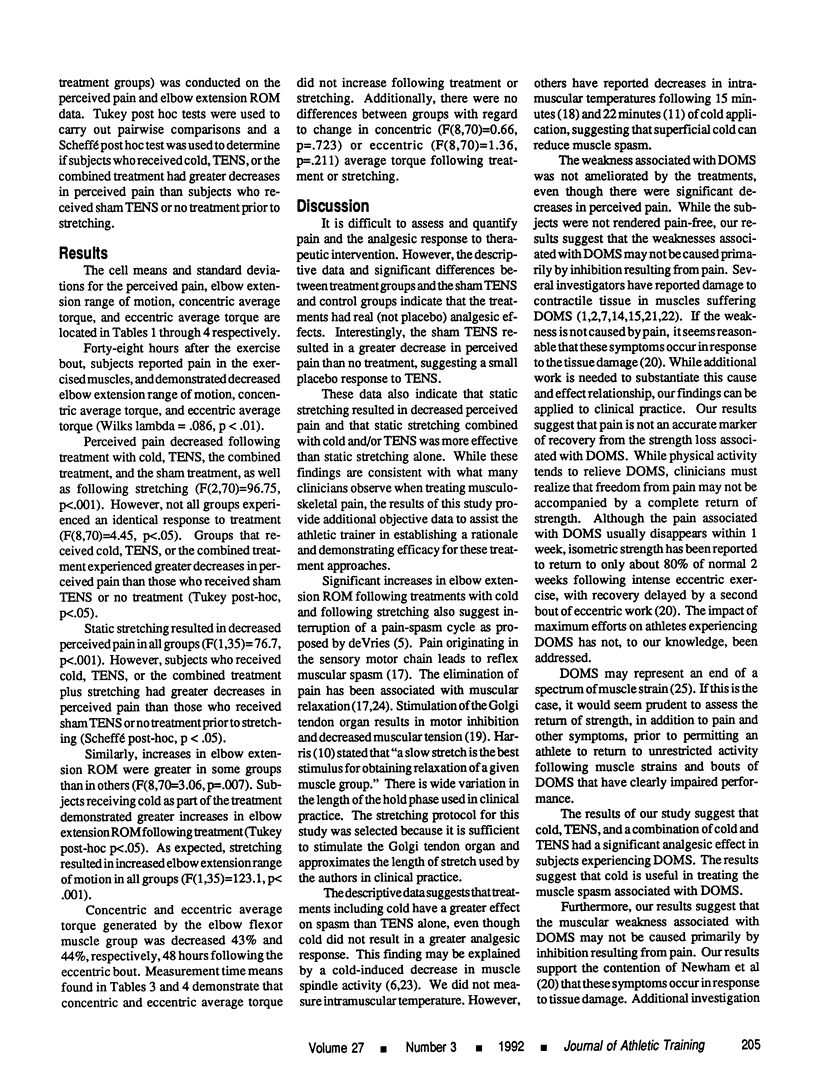
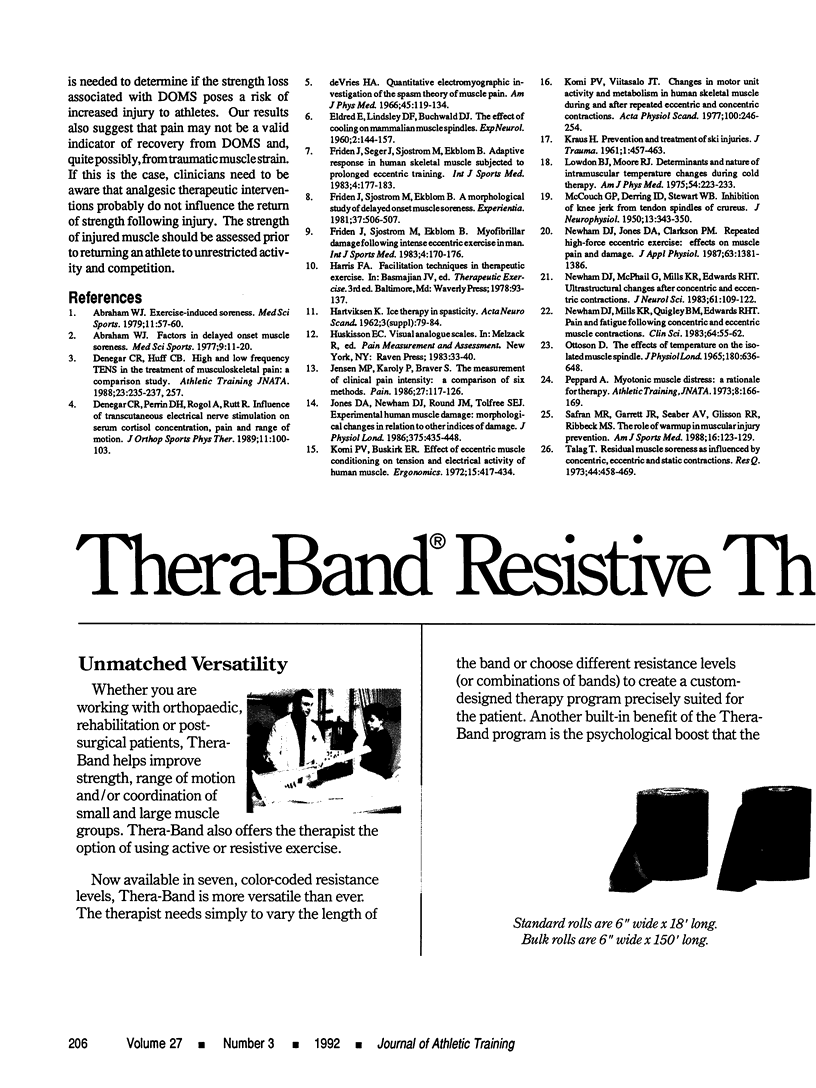
Selected References
These references are in PubMed. This may not be the complete list of references from this article.
- Abraham W. M. Factors in delayed muscle soreness. Med Sci Sports. 1977 Spring;9(1):11–20. [PubMed] [Google Scholar]
- De Vries H. A. Quantitative electromyographic investigation of the spasm theory of muscle pain. Am J Phys Med. 1966 Jun;45(3):119–134. [PubMed] [Google Scholar]
- ELDRED E., LINDSLEY D. F., BUCHWALD J. S. The effect of cooling on mammalian muscle spindles. Exp Neurol. 1960 Apr;2:144–157. doi: 10.1016/0014-4886(60)90004-2. [DOI] [PubMed] [Google Scholar]
- Fridén J., Seger J., Sjöström M., Ekblom B. Adaptive response in human skeletal muscle subjected to prolonged eccentric training. Int J Sports Med. 1983 Aug;4(3):177–183. doi: 10.1055/s-2008-1026031. [DOI] [PubMed] [Google Scholar]
- Fridén J., Sjöström M., Ekblom B. A morphological study of delayed muscle soreness. Experientia. 1981 May 15;37(5):506–507. doi: 10.1007/BF01986165. [DOI] [PubMed] [Google Scholar]
- Fridén J., Sjöström M., Ekblom B. Myofibrillar damage following intense eccentric exercise in man. Int J Sports Med. 1983 Aug;4(3):170–176. doi: 10.1055/s-2008-1026030. [DOI] [PubMed] [Google Scholar]
- Jensen M. P., Karoly P., Braver S. The measurement of clinical pain intensity: a comparison of six methods. Pain. 1986 Oct;27(1):117–126. doi: 10.1016/0304-3959(86)90228-9. [DOI] [PubMed] [Google Scholar]
- Jones D. A., Newham D. J., Round J. M., Tolfree S. E. Experimental human muscle damage: morphological changes in relation to other indices of damage. J Physiol. 1986 Jun;375:435–448. doi: 10.1113/jphysiol.1986.sp016126. [DOI] [PMC free article] [PubMed] [Google Scholar]
- KRAUS H. Prevention and treatment of skiing injuries. J Trauma. 1961 Sep;1:457–463. [PubMed] [Google Scholar]
- Komi P. V., Buskirk E. R. Effect of eccentric and concentric muscle conditioning on tension and electrical activity of human muscle. Ergonomics. 1972 Jul;15(4):417–434. doi: 10.1080/00140137208924444. [DOI] [PubMed] [Google Scholar]
- Komi P. V., Viitasalo J. T. Changes in motor unit activity and metabolism in human skeletal muscle during and after repeated eccentric and concentric contractions. Acta Physiol Scand. 1977 Jun;100(2):246–254. doi: 10.1111/j.1748-1716.1977.tb05943.x. [DOI] [PubMed] [Google Scholar]
- Lowdon B. J., Moore R. J. Determinants and nature of intramuscular temperature changes during cold therapy. Am J Phys Med. 1975 Oct;54(5):223–233. [PubMed] [Google Scholar]
- McCOUCH G. P., DEERING I. D., STEWART W. B. Inhibition of knee jerk from tendon spindles of crureus. J Neurophysiol. 1950 Sep;13(5):343–349. doi: 10.1152/jn.1950.13.5.343. [DOI] [PubMed] [Google Scholar]
- Newham D. J., Jones D. A., Clarkson P. M. Repeated high-force eccentric exercise: effects on muscle pain and damage. J Appl Physiol (1985) 1987 Oct;63(4):1381–1386. doi: 10.1152/jappl.1987.63.4.1381. [DOI] [PubMed] [Google Scholar]
- Newham D. J., McPhail G., Mills K. R., Edwards R. H. Ultrastructural changes after concentric and eccentric contractions of human muscle. J Neurol Sci. 1983 Sep;61(1):109–122. doi: 10.1016/0022-510x(83)90058-8. [DOI] [PubMed] [Google Scholar]
- Newham D. J., Mills K. R., Quigley B. M., Edwards R. H. Pain and fatigue after concentric and eccentric muscle contractions. Clin Sci (Lond) 1983 Jan;64(1):55–62. doi: 10.1042/cs0640055. [DOI] [PubMed] [Google Scholar]
- Ottoson D. The effects of temperature on the isolated muscle spindle. J Physiol. 1965 Oct;180(3):636–648. doi: 10.1113/jphysiol.1965.sp007721. [DOI] [PMC free article] [PubMed] [Google Scholar]
- Rogol A. D. Anabolic steroid therapies for growth disorders. Hosp Pract (Off Ed) 1989 Nov 15;24(11):89-92, 97-100, 103-6. doi: 10.1080/21548331.1989.11703812. [DOI] [PubMed] [Google Scholar]
- Safran M. R., Garrett W. E., Jr, Seaber A. V., Glisson R. R., Ribbeck B. M. The role of warmup in muscular injury prevention. Am J Sports Med. 1988 Mar-Apr;16(2):123–129. doi: 10.1177/036354658801600206. [DOI] [PubMed] [Google Scholar]
- Talag T. S. Residual muscular soreness as influenced by concentric, eccentric, and static contractions. Res Q. 1973 Dec;44(4):458–469. [PubMed] [Google Scholar]


